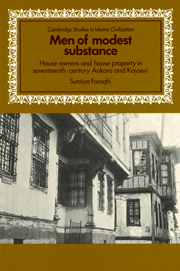Book contents
- Frontmatter
- Contents
- Tables
- Graphs
- Illustrations
- Figures
- Abbreviations
- Preface
- Introduction
- 1 Setting the scene: two cities of central Anatolia
- 2 The physical shape of urban houses
- 3 The cost of buying a house
- 4 Urban property-owners
- 5 The difficulties of an urban property-owner
- Conclusion
- Glossary
- Notes
- Bibliography
- Index
4 - Urban property-owners
Published online by Cambridge University Press: 18 November 2009
- Frontmatter
- Contents
- Tables
- Graphs
- Illustrations
- Figures
- Abbreviations
- Preface
- Introduction
- 1 Setting the scene: two cities of central Anatolia
- 2 The physical shape of urban houses
- 3 The cost of buying a house
- 4 Urban property-owners
- 5 The difficulties of an urban property-owner
- Conclusion
- Glossary
- Notes
- Bibliography
- Index
Summary
In the course of the present investigation, we have gradually moved from a description of the built-up environment towards investigating the social characteristics of urban house-owners. A discussion of prices commonly paid for dwellings has provided some data which can be used in identifying the rich and the poor. Both the description of the urban environment and the discussion of prices were intended as a means towards understanding the social structure of a large Anatolian town, and to find out how this structure evolved in the course of the seventeenth century. At the same time, we also possess some data which directly inform us whether a given urban house-owner was a male or a female, a Muslim or a non-Muslim, an official associated with the Ottoman central administration (askerî) or an ordinary taxpayer (reaya). In the present chapter, we will concentrate upon the analysis of these personal data concerning house owners of seventeenth-century Ankara and Kayseri.
Since the main sources of information on these matters are the names of the people involved, a few remarks concerning naming practices are necessary. As is well known, only wealthy and influential families possessed what might be regarded as a surname. In certain instances, the family's name might attach itself to the building inhabited by its members. Thus, the remains of an elaborate Kayseri dwelling, whose core may go back to the fifteenth century, are still known today as the konak of the Gübgüb oǧulları.
However, in the vast majority of cases, both Muslims and non-Muslims were identified by their given names and by their fathers' names. With respect to women, the same rules were observed.
- Type
- Chapter
- Information
- Men of Modest SubstanceHouse Owners and House Property in Seventeenth-Century Ankara and Kayseri, pp. 150 - 181Publisher: Cambridge University PressPrint publication year: 1987

